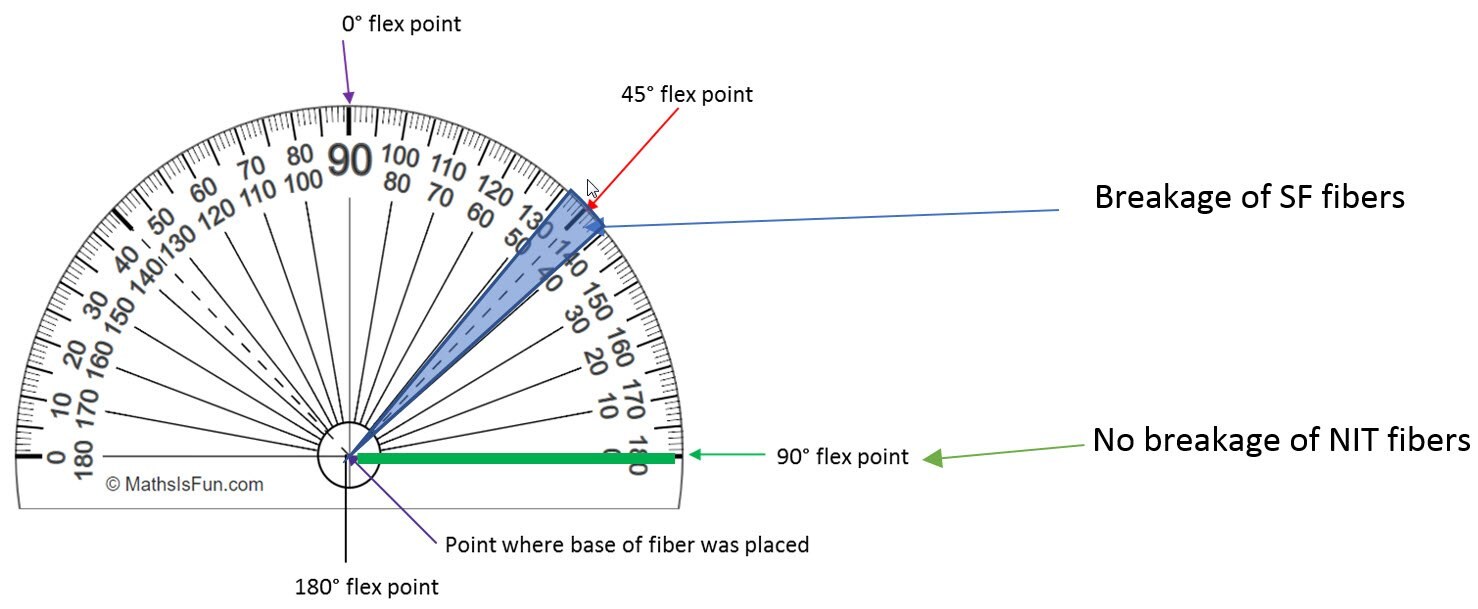Rugged and Reproducible Solid Phase Microextraction (SPME) Sampling
Elevate your fiber performance with nitinol-core
SPME fibers
SPME fibers with Carboxen®/Polydimethylsiloxane (CAR/PDMS) and Polydimethylsiloxane/ Divinylbenzene (PDMS/DVB) coatings are now available on a nitinol core (NIT) in a SS assembly for improved fiber performance. Selectivity of the CAR/PDMS and PDMS/DVB SPME fibers has been maintained for seamless transition of methods from fused-silica core (FS) fibers to the improved NIT technology. NIT fibers offer the following benefits:
- Enhanced fiber reproducibility
- Greater fiber durability
- Maintained selectivity for method consistency
- Core inertness to ensure analyte stability

Improved Lot-to-Lot and Fiber-to-Fiber Reproducibility
The nitinol-core SPME manufacturing process has been optimized to enhance lot-to-lot and fiber-to-fiber reproducibility. This enhanced reproducibility stems from more stringent coating specifications reducing fiber variation significantly in particular for fiber diameter/coating thickness.
The improvements provide enhanced precision of chromatographic results. The NIT CAR/PDMS and NIT PDMS/DVB fibers were compared to FS versions of the same fiber chemistry following the methodology detailed in Table 1 and visually represented in Figure 1. The Figure 2 shows that both the NIT CAR/PDMS fibers and NIT PDMS/DVB fibers exhibit significant reduction in intra-lot variability and inter-lot variability as compared to the FS version.

Figure 1.Representative Chromatogram of the Analytical Testing Method Depicted on a CAR/PDMS NIT Fiber

Figure 2.Inter-lot and Intra-lot Reproducibility Testing Comparing NIT and FS SPME Fibers
Greater SPME Fiber Durability
NIT provides improved durability over FS fibers. In this comparison, the NIT and FS fibers were subjected to a flexibility test to determine fiber strength/mechanical stability. Three FS core fiber and three NIT core fiber assemblies of each coating were flexed from 0° to 180° as indicated in Figure 3. NIT fibers were flexed to 180° without breaking or permanently kinking regardless of coating type.
Figure 4 shows a 90° flexion of a NIT fiber. FS fiber assemblies regardless of coating type broke off at the point of attachment when flexed between 40° and 50°. Despite the increase in mechanical stability it is still recommended to minimize the mechanical stress to the coated fibers as much as possible.

Figure 3.Flexion Points for Durability Test

Figure 4.90° flexion of a NIT fiber
SPME Coating Selectivity and Core Inertness Maintained
To facilitate seamless transfer of methods from FS fibers to the NIT fibers of the same coating type, selectivity and inertness were compared to ensure consistency using two sets of indicator compounds: alkyl halides and small short chain amines. Comparisons were performed on four lots of CAR/PDMS and PDMS/DVB of each core type to confirm repeatability of results.
The selectivity of CAR/PDMS and PDMS/DVB fibers for the alkyl halides on each core type was examined through a comparison of analyte response rates using the method outlined in Table 2. Figure 5 shows that coating selectivity is maintained for both the CAR/PDMS and PDMS/DVB chemistries for the alkyl halides regardless of core type. The difference between responses of halogenated alkanes extracted using coatings on NIT and FS cores was less than 3% for all coatings. Because alkyl halides are known to breakdown at elevated temperatures upon interaction with exposed active sites, the inertness of the two fiber types was then investigated to ensure that no increase in degradation was taking place on the NIT fibers. Percent conversion of the studied alkyl halide to their corresponding alkene is displayed in Figure 6. For all analytes, which are known to be prone to degradation, NIT fibers exhibit equal or better preservation of sample for both coating types. Percent breakdown was also found to be correlated with temperature, as anticipated.
Inertness and selectivity of the fibers was then compared for more polar compounds using the series of short chain amines. Short chain amines also tend to be problematic analytes due to their reactivity with metal which results in oxidative degradation that intensifies at elevated temperatures. The analyte response of each amine was divided by the internal standard, n-propanol, which is stable under these conditions, to examine amine breakdown or irreversible adsorption. If breakdown were to occur, the ratio would be lower on a more active core. The chromatogram and ratios depicted in Figure 7 indicate that the selectivity and core inertness is maintained between the FS and NIT fibers for the amine series. The values are statistically the same at 5% RSD.

Figure 5.Alkyl Halide Analyte Responses by Core Type and Coating

Figure 6.Core Inertness Study on the Breakdown of Alkyl Halides


Figure 7.Core Inertness and Analyte Response Comparison of Amines in Relation to n-Propanol on NIT and FS Fibers
Benefits of nitinol-core SPME fibers
The nitinol-core SPME fibers show enhanced lot-to-lot as well as fiber-to-fiber reproducibility. The coating consistency has been optimized lending to an improvement in repeatability of analytical results. Durability of the fibers has been vastly increased by the NIT core allowing the fibers to handle 180° distortion. With these improvements, the selectivity and inertness of the CAR/PDMS or PDMS/DVB SPME FS fibers is maintained allowing simple transfer of methods from the FS version to the new NIT variety.
To continue reading please sign in or create an account.
Don't Have An Account?